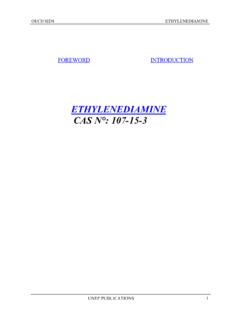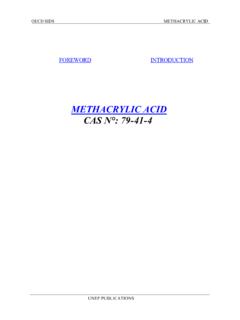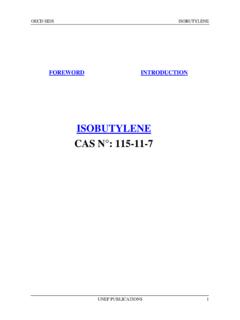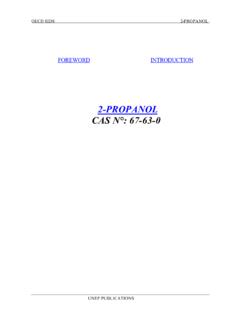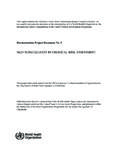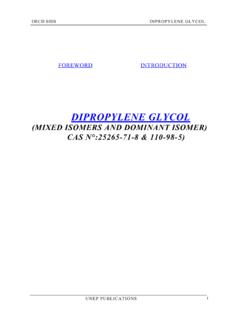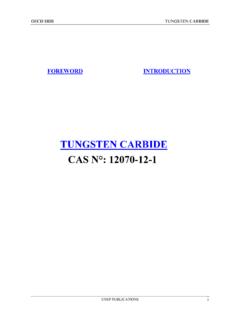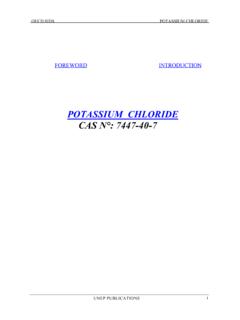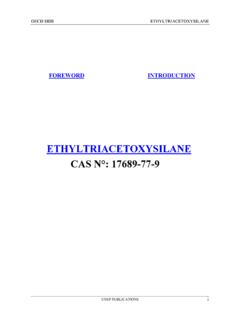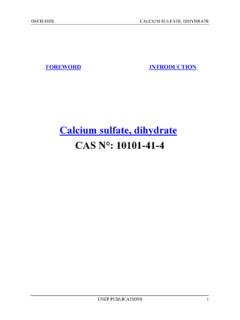Transcription of o-TOLUIDINE CAS N°: 95-53-4 - IPCS INCHEM
1 OECD SIDS o-TOLUIDINE UNEP PUBLICATIONS 1 FOREWORD INTRODUCTION o-TOLUIDINE CAS N : 95-53-4 OECD SIDS o-TOLUIDINE UNEP PUBLICATIONS 2 SIDS Initial Assessment Report For SIAM 19 (Berlin, October 19 22, 2004) 1.
2 Chemical Name: o-TOLUIDINE 2. CAS Number: 95-53-4 3. Sponsor Country: Germany Contact Point: BMU (Bundesministerium f r Umwelt, Naturschutz und Reaktorsicherheit) Contact person: Prof. Dr. Ulrich Schlottmann Postfach 12 06 29 D- 53048 Bonn 4. Shared Partnership with: 5. Roles/Responsibilities of the Partners: Name of industry sponsor /consortium Bayer AG, Germany Contact person: Dr. Burkhardt Stock D-51368 Leverkusen Building 9115 Process used The BUA Peer Review Process : see next page 6. Sponsorship History How was the chemical or category brought into the OECD HPV Chemicals Programme ?
3 By ICCA-Initiative 7. Review Process Prior to the SIAM: last literature search (update): 13 April 2004 (Human Health): databases medline, toxline; search profile CAS-No. and special search terms 19 March 2004 (Ecotoxicology): databases CA, biosis; search profile CAS-No. and special search terms OECD/ICCA 8. Quality check process: As basis for the SIDS-Dossier the IUCLID was used. All data have been checked and validated by BUA. A final evaluation of the human health part has been performed by the Federal Institute for Risk Assessment (BfR) and of the ecotoxicological part by the Federal Environment Agency (UBA).
4 9. Date of Submission: Deadline for circulation: 23 July 2004 10. Date of last Update: Last literature search: IUCLID Chapters 1-4: 2003-08-26 Chapter 5: OECD SIDS o-TOLUIDINE UNEP PUBLICATIONS 311. Comments: CICAD, 1998, is available and used as review. For the SIDS Dossier and the SIAR original literature was evaluated.
5 OECD/ICCA - The BUA* Peer Review Process Qualified BUA personnel (toxicologists, ecotoxicologists) perform a quality control on the full SIDS dossier submitted by industry. This quality control process follows internal BUA guidelines/instructions for the OECD/ICCA peer review process and includes: - a full (or update) literature search to verify completeness of data provided by industry in the IUCLID/HEDSET - Review of data and assessment of the quality of data - Review of data evaluation - Check of adequacy of selection process for key studies for OECD endpoints, and, where relevant, for non-OECD endpoints by checking original reports/publications - Review of key study description according to robust summary requirements.
6 Completeness and correctness is checked against original reports/publications (if original reports are missing: reliability (4), reliability not assignable) - Review of validity of structure-activity relationships - Review of full SIDS dossier (including SIAR, SIAP and proposal for conclusion and recommendation for further work) - In case of data gaps, review of testing plan or rationale for not testing * BUA (GDCh-Beratergremium f r Altstoffe): Advisory Committee on Existing Chemicals of the Association of German Chemists (GDCh) OECD SIDS o-TOLUIDINE UNEP PUBLICATIONS 4 SIDS INITIAL ASSESSMENT PROFILE CAS No.
7 95-53-4 Chemical Name o-TOLUIDINE Structural Formula NH2CH3 SUMMARY CONCLUSIONS OF THE SIAR Human Health o-TOLUIDINE is rapidly absorbed via gastrointestinal tract and is rapidly distributed, metabolized and excreted mainly via urine. Although there are no special toxicokinetic data on absorption via skin and respiratory tract, absorption via these administration routes is shown by data from acute toxicity studies.
8 The LC50 (rat) is 852 ppm/4 hrs (approx. 3827 mg/m3/4 hrs), and oral LD50 (rat) is 750 mg/kg bw. The dermal LD50 (rabbit) is 3250 mg/kg bw in a limited study. The predominant symptoms after inhalation or oral application were cyanosis, labored breathing, lethargy or loss of consciousness. o-TOLUIDINE is a methemoglobin forming chemical; this was shown in rat and cat as well as in humans. o-TOLUIDINE is not irritating to the skin of rabbits when tested for 24 hours under semi-occlusive conditions (rabbit, ear) and is moderately irritating when tested 24 hours under occlusive conditions (rabbit, skin).
9 However, skin necrosis developed 72 hours post treatment in 1/6 animals under occlusive conditions. o-TOLUIDINE causes serious damage to the eyes of rabbits. There are no valid data available to evaluate the sensitization potential of o-TOLUIDINE . Repeated dose studies show that o-TOLUIDINE is toxic to erythrocytes and a methemoglobin forming chemical. This was demonstrated in elevated methemoglobin levels up to % in the subacute feeding study as well as in the marked splenic toxicity in the subacute gavage and subchronic feeding studies leading to hypercellularity in the bone marrow.
10 Further target organs were liver and kidney (hemosiderin deposition) and urinary bladder (hyperplasia). Based on the hematological findings no NOAEL could be derived, the LOAEL (rat, 14-day feeding study) is 500 ppm (approx. and mg/kg bw/day for males and females, respectively). Genotoxicity test results are as typical for the class of aromatic amines. o-TOLUIDINE showed positive as well as negative results in point mutation assays in bacteria and yeast. Results from tests with mammalian cell systems (HPRT, TK, UDS) were inconsistent, too, and appear to be protocol dependent.
